#cemetery botany
Explore tagged Tumblr posts
Text

We decided to take advantage of the nice weather and visit some cemeteries we haven't been to before. Serendipitously, we came across devil's cigar (Chorioactis geaster), the enigmatic fungus known from a couple of counties in Texas, one site in Oklahoma, and Japan - though the Texan and Japanese populations seem to have diverged approximately 19 million years ago.
932 notes
·
View notes
Text




Wildflowers enveloping the monuments at Mt. Auburn Cemetery
#ecology#wildflowers#botany#echinacea#coreopsis#cemetery#spooky season#death#native plants#asclepias#solidago
5 notes
·
View notes
Text
ty @there-must-be-a-lock for another awesome @dc-marvel-crossovers event!!
title roulette gave me "Screaming Through the Night" with the optional tags "Hurt/Comfort, Murder Husbands, Resurrection."
plz enjoy Screaming Through the Night, part II of Deadly Night Shades.
#my writing#crash the cemetery gates#screaming through the night#deadly night shades#clint barton#jason todd#rare pairs#count on me to make a poison botany reference
3 notes
·
View notes
Text






New Jewish Cemetery, Riga, Latvia
#grille#window#gate#cemetery#Riga#Latvia#2023#black grille#symbolic grille#celestial grille#symmetrical grille#misc grille#brown grille#rusty grille#assorted grilles#botany grille
12 notes
·
View notes
Text
“Cemeteries are full of life,” says biologist Anne Pringle as she walks through the Forest Hill Cemetery in Madison, Wisconsin. It’s a bright, early October day and sunlight filters through the still-green leaves, catching strands of spider silk spun over tombstone crosses. Speckled mushrooms stand sentry over the manicured grass as squirrels chatter overhead. But the form of life that brought Pringle here is subtler: Her work focuses on the green and rust-colored splotches growing on the headstones. These growths, called lichens, may help reveal biological rules governing life, death, aging, and even immortality. And because lichens tend to grow undisturbed on tombstones, graveyards make the perfect living laboratory. Despite an often moss-like appearance, lichens are complex living things, arguably more closely related to animals than to plants. They’re made up of fungi living in partnership with algae or bacteria that can perform photosynthesis. “A lichen is a symbiosis, or it’s an ecosystem, or it’s a world,” says Pringle, a professor of botany and bacteriology at the University of Wisconsin-Madison. “It’s an interwoven, complex web of interactions.” Fungi, like their animal cousins, can’t produce their own food the way that plants can. Many of them get nourishment by breaking down organic matter. But the fungi that make up lichens have found a different solution: living with algae and bacteria that use air and sunlight to make sugar. The fungus is nourished by these sugars and, in return, it provides the smaller organisms with a home.
continue reading
6 notes
·
View notes
Text
Destination Dream Weddings, Driving Disasters, & Dented Derrieres: A Fic Collaboration Between @kmomof4 @snowbellewells @whimsicallyenchantedrose and @jrob64
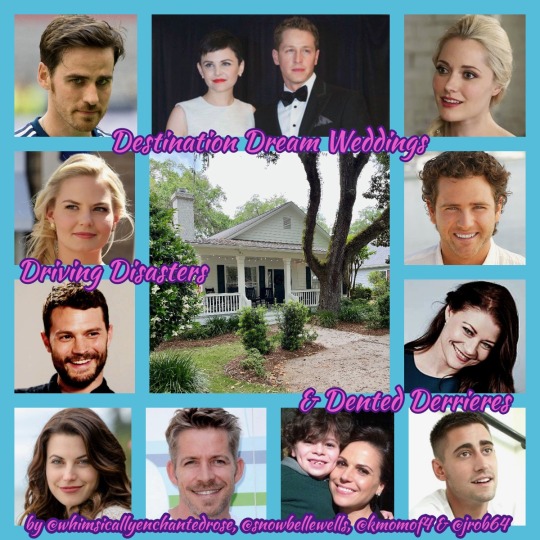
Ready for Ch3, y'all? Here we go! In today's installment, we are heading to Savannah for sightseeing and the bachelor and bachelorette parties!!
Rating: T
Words: 3700 of approx 21k
On ao3 and ff.net
Under the cut, unless Tumblr ate it.
The second full day of their vacation dawned bright and sunny without a cloud in the sky. It was a gorgeous day, and Emma found herself looking forward to their planned excursion in Savannah. She donned a breezy, sleeveless, white sundress sprinkled with yellow sunflowers and her favorite pair of comfortable strappy white sandals.
While normally one to simply toss clothing options into her suitcase, she’d needed to put a little more effort into packing on this trip with all their scheduled adventures, and today’s outfit was no exception. They planned to spend a fair amount of time walking around Savannah today, and then she and Ruby had organized a bachelorette party for tonight. Given the itinerary, she’d needed an outfit casual enough for a stroll through the city and yet dressy enough for a night out with the girls.
“You look tantalizing enough to tempt a man to stay home and have his wicked way with you, Swan,” Killian said, coming up behind her in the living room, wrapping his arms around her middle and nosing at her hair, before placing a not-quite-chaste kiss at the base of her neck.
She shivered in response. When he used that tone of voice, all low and gravelly and full of sin, she nearly forgot her own name.
“What, and miss out on Savannah?” she asked, her voice far from steady.
“I’ve no doubt Savannah has many charms, Love,” he said, still peppering her with kisses, “but she couldn’t possibly hold a candle to you.”
“Oi! Get a room you two!” Will said, opening the cottage door and breezing in.
“They already have one,” Regina said with an eye roll as she came into the room where they were all gathered, “and if we have to wait for them to make use of it, we’ll never get to Savannah, and I, for one, am looking forward to touring the cemetery.”
“That’s not creepy at all,” Emma said under her breath.
“It’s actually not creepy at all!” Belle said, standing close enough to her friend that she heard exactly what was said. “The cemeteries there are so old, there’s so much history! It’s fascinating.”
“I’m interested in taking a stroll along the river, getting a gander at the establishments and riverboats,” Liam said.
“I’d like to walk through the squares under the shade of all of those big, beautiful live oaks,” Mary Margaret said. “I wonder why they’re called live oaks?”
“It’s because they are semi-deciduous,” Graham said. “They never lose all of their leaves. There’s also a bit about the Spanish moss that clings to them–which is neither Spanish, nor moss, by the way. It got its name because…”
“Let’s save the botany lectures for the road,” Regina said dismissively. “It’s an hour and a half drive, and if we wait for everyone to share all their collective knowledge, we’ll never get there.”
“Regina, did you just call us smart?” Will asked.
“You’re the exception that proves the rule,” she snarked.
With only one day to spend in Savannah, they knew they couldn’t possibly see everything they hoped to see, and so they planned on splitting up - Emma, Killian, Elsa and Liam taking the riverwalk, Regina, Robin, Roland, Belle and Will touring Bonaventure Cemetery, and Graham, Ruby, Mary Margaret and David strolling through the various squares and touring the shopping district.
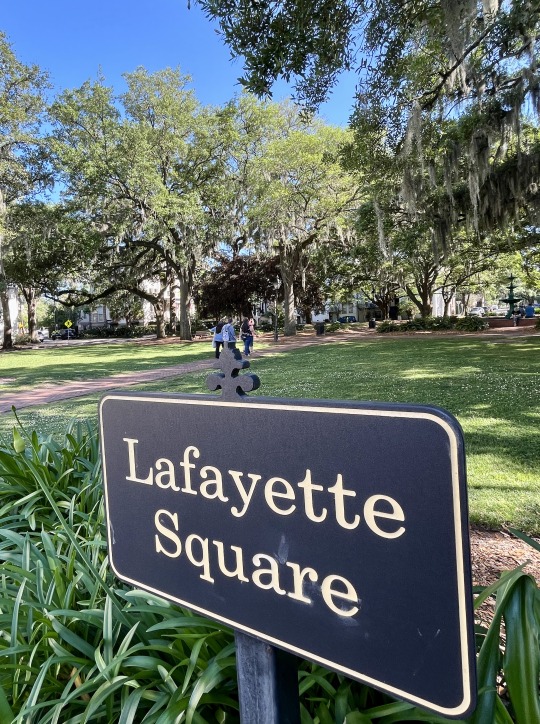
With their plans made, they headed to their respective cars for the drive north.
Two hours later, Emma and Killian walked hand in hand down the sidewalk overlooking the river. It was a beautiful day, quite mild for Savannah in July and with a refreshing light breeze.

“So, you’re having dinner at The Melting Pot, right?” Killian asked.
Emma nodded. “Then Ruby found something for dessert that she’s refused to tell even me.”
“Any idea what it might be?” he asked.
“Nope,” Emma chuckled. “Knowing Ruby, it’ll be as risqué as she can possibly get by with and still remain within Mary Margaret’s requirements.”
“Was Ruby particularly disappointed with her stipulation against strippers?” he asked with a grin.
Emma laughed. “Actually, it was the opposite. She just shrugged and said it’s no big deal. She’ll have Graham give her a strip tease when she gets home.”
Killian laughed. “And I’d assume the man in question went quite vermillion at that?”
“Naturally.”
“Killian, look at that,” Liam said, gesturing to the row of shops and restaurants across the street. “Who in their right mind would choose to name their establishment The Broken Keel?”
Killian shook his head derisively, “Bloody fools, that’s who.”
“So, I take it you aren’t interested in going there for lunch?” Elsa asked slyly.
“No!” both men shouted emphatically, causing the women to go off into peals of laughter.
The foursome continued their walk, enjoying the company and the sights of the historic district, the men particularly interested in the majestic river boats docked and awaiting passengers, and the women more interested in the shops and sculptures.
Emma had been fascinated listening to an old man with a long, white beard play his saxophone as he sat on a bench near the river. From the alleyway behind came the sound of a man singing, clapping, and tapping his feet. The city was so vibrant and alive and full of joie de vivre.
She turned around to comment about it to Killian, but her boyfriend was nowhere to be found.
“Looks like we lost your brother,” she commented to Liam. “Let’s hope he didn’t fall in the river.”
Liam laughed and then gave her a look she couldn’t interpret. “I believe he headed toward the riverboats to make some inquiries.”
“Inquiries about what?” she asked.
Liam merely shrugged and then determinedly changed the subject.
Suspicious. Very suspicious.
But then Killian was rejoining their group and they were off again, and Emma put the strange incident from her mind.
~*~*~
As the day settled into evening, the men and women met up again to head to their respective bachelor and bachelorette parties. While the men had reservations for a dinner at the historic Pirate’s House, Ruby announced the locations of the bachelorette party with a mischievous look in her eye.
“First, Emma made dinner reservations for us at The Melting Pot. But no dessert,” she continued, shaking her finger at them all as they ooo-ed and ahhh-ed over Emma’s choice. “I found somewhere else for that. It’s this amazing place called Better Than Sex - A Dessert Restaurant. Who doesn’t like their cake with a spicy dose of innuendo?”
Mary Margaret groaned…although if the dessert was as good as all that, she wouldn’t complain about their plans for the night. After taking a few moments to say goodbye to their men, the ladies made their way to The Melting Pot.
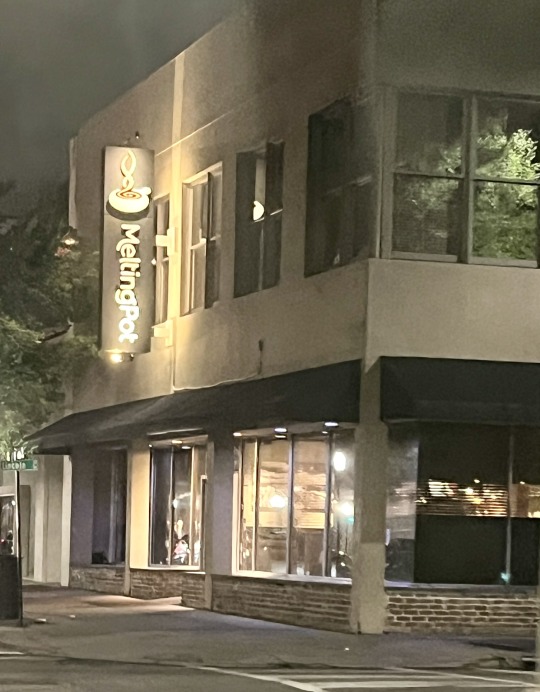
After their delicious and rather entertaining meal, they walked down the street to the dessert bar. Ruby had reserved a table for a private party, and as soon as the ladies arrived, their friendly, smiling waiter led them up to a room with red walls, plush carpeting, opulent chandeliers and gauzy white curtains covering the windows and ceiling. The room was dimly lit by flickering candles that lined a long banquet table, the chandeliers being more for ambiance than illumination. The smooth jazz music issuing from the sound system completed the atmosphere, and Mary Margaret rather felt as though they were having dessert in a very fancy boudoir.
“Are you ladies celebrating anything in particular tonight?” the server asked, glancing around the group.
“It’s her bachelorette party!” Ruby announced, pointing one exquisitely manicured finger in Mary Margaret’s direction. “She’s gonna tie the knot the day after tomorrow!”
“Congratulations!” the server beamed, “and might I say, you’ve come to the right place. I’m not just saying this; these desserts are to die for. I’ll give you a chance to look over the menu.”
“Order anything you want,” Belle said to Mary Margaret, as soon as the waiter withdrew. “It’s on us; we’re all pitching in.”
Mary Margaret took a sip of the water sitting before her place setting just as she began to peruse the selections, and she almost spit out the sip she’d taken.
“Oh my! These dessert names are…quite something,” Elsa said with a little chuckle.
“That’s one way to put it,” Mary Margaret agreed with a smile and a shake of her head. The selections on offer had spicy names such as “Pound Town”, “Berry Bondage”, “Naughty by Nature”, “Man Flowers” and “Peanut Butter Perversion.” The descriptions themselves were so steamy they wouldn’t have been out of place on the pages of one of those bodice ripper novels with a half-naked Adonis on the cover.
After some deliberation, she decided to go with the titillatingly-named Hot Sex in Savannah. “Your wildest fantasies have come true!” the menu read. “Georgia peaches have gotten frisky with a little bourbon, pecans, and roasted habanero to reproduce a smokin’ good time. As if you weren’t already having a ball, we’ve added a friend for you to flirt with...... a tickle of our house-made bacon ice cream.”
“What’s everyone getting?” Ruby asked. “I decided to go with the ‘Between My Red Velvet Sheets Cheesecake’.”
After a little discussion, everyone made their selections. Regina ordered the ‘Missionary Crisp’--an apple and cake-like confection. Emma opted for the ‘Morning After’ to no one’s surprise–it, after all, consisted of a chocolate and brie grilled cheese. Elsa chose the ‘Perfect Partner’, essentially a sundae made from vanilla bean ice cream and white chocolate. Belle rounded out the order with the very suggestively titled ‘Caress My Carrot’, perhaps the most decadent slice of carrot cake ever baked.
The restaurant was so very committed to its naughty puns, it had a note at the bottom of the menu that said 'and no suggestive dessert is truly complete without an equally racy cocktail'. They ordered such colorful drinks as ‘Midnight Vixen’, ‘Love Potion 69’, ‘Minty Moaner’, ‘Tingly-Tini’ and ‘Peanut-Tration’.
Mary Margaret noticed that Elsa was discreetly perusing the section almost tamely-labeled ‘for virgins.’
“So….you’re foregoing the alcohol tonight, I see,” Mary Margaret said, drawing out the first word meaningfully.
“I’ve never found a cocktail I really like,” Elsa said, studiously avoiding her friend’s gaze, a small, secret smile on her lips. “And besides, we need someone to be the designated driver.”
Mary Margaret wasn’t buying that for a moment, but before she could dig deeper to find out whether the secret hunch she’d carried since overhearing Elsa and Liam’s conversation was correct, their food and drinks arrived, and with that, all other thoughts were forgotten.
For long minutes after their desserts were served, the only sounds to be heard were soft exclamations, hums of satisfaction, and moans of ecstasy. There was no doubt about it, Mary Margaret decided. These desserts did not oversell themselves. How they’d managed to turn what was essentially a peach cobbler into such a rich, decadent, and spicy explosion of flavor on her tongue was beyond her.
“So what did you think?” Ruby asked. “Did it live up to its name?”
Mary Margaret thought for a moment. “It was good. It was very good,” she repeated, “but better than sex?” She shook her head with a smug smile. “Not a chance.”
“I did not need to hear that,” Emma muttered.
But in the end, all the ladies had to agree.
~*~*~

The men emerged from their vehicles in the parking lot of The Pirate’s House, the world famous restaurant housed in one of Savannah’s oldest buildings. The structure, only a block from the riverfront, was originally built in 1734 - a year after the town’s founding - as the quarters for the keeper of the Trustees’ Garden, the first public agricultural experimental garden in America. By the early 1750’s, Savannah was a vibrant and thriving port city and The Herb House, as it had been named, was converted into an inn that attracted sailors and pirates alike. Legend said the infamous Captain Flint actually died inside the historic building.
“And perhaps, lingers still,” Killian intoned, his eyebrows waggling in intrigue at little Roland, whose eyes resembled round saucers.
“Really?” His high pitched screech made the men chuckle. “Is it haunted, Papa? Are we gonna see a ghost?” His voice got impossibly higher as he all but jumped up and down grabbing the hem of Robin’s shirt. “ARE WE GONNA SEE THE GHOST OF CAPTAIN FLINT, PAPA?”
“Not quite, Roland,” Robin explained. “Uncle Killian doesn’t quite have his facts straight.”
“Oi!” Killian protested.
“Captain Flint wasn’t a real pirate,” Robin continued, as if Killian hadn’t spoken at all. “He wasn’t even a real man. He’s a character in the story of Treasure Island written by Robert Louis Stevenson back in the 1880’s.”
“Wowwww,” Roland breathed. “So when you and Uncle Liam were little?” he asked, innocently. Loud guffaws burst out of Killian and Will alike, with Graham and David able to contain their mirth a little better, hiding their laughter behind their hands, their eyes dancing in amusement. Liam snorted and shook his head.
“We’re not that old,” Robin chuckled, ruffling Roland’s curls, “But it is said that The Pirate’s House inspired Stevenson to write it, using a fictional Captain Flint to set the story in motion.”
The men and little boy stepped onto the porch and through the door of the establishment to be greeted by the hostess. The exterior was gray wooden clapboard with light blue shutters over very weathered red brick, but when they stepped inside, the dark wood paneling, low wooden ceilings, and various piratical accoutrements scattered around were enough to make one feel as if he really had stepped back in time a couple hundred years.
In the corner across from the door, a life-sized carved wooden pirate stood sentry at the crossroads between the bar (for Thirsty Pirates, according to the small sign above the hostess station pointing left), restaurant (for Hungry Pirates, according to another sign pointing to the right), and the stairs leading up to the second story where the gift shop could be found.
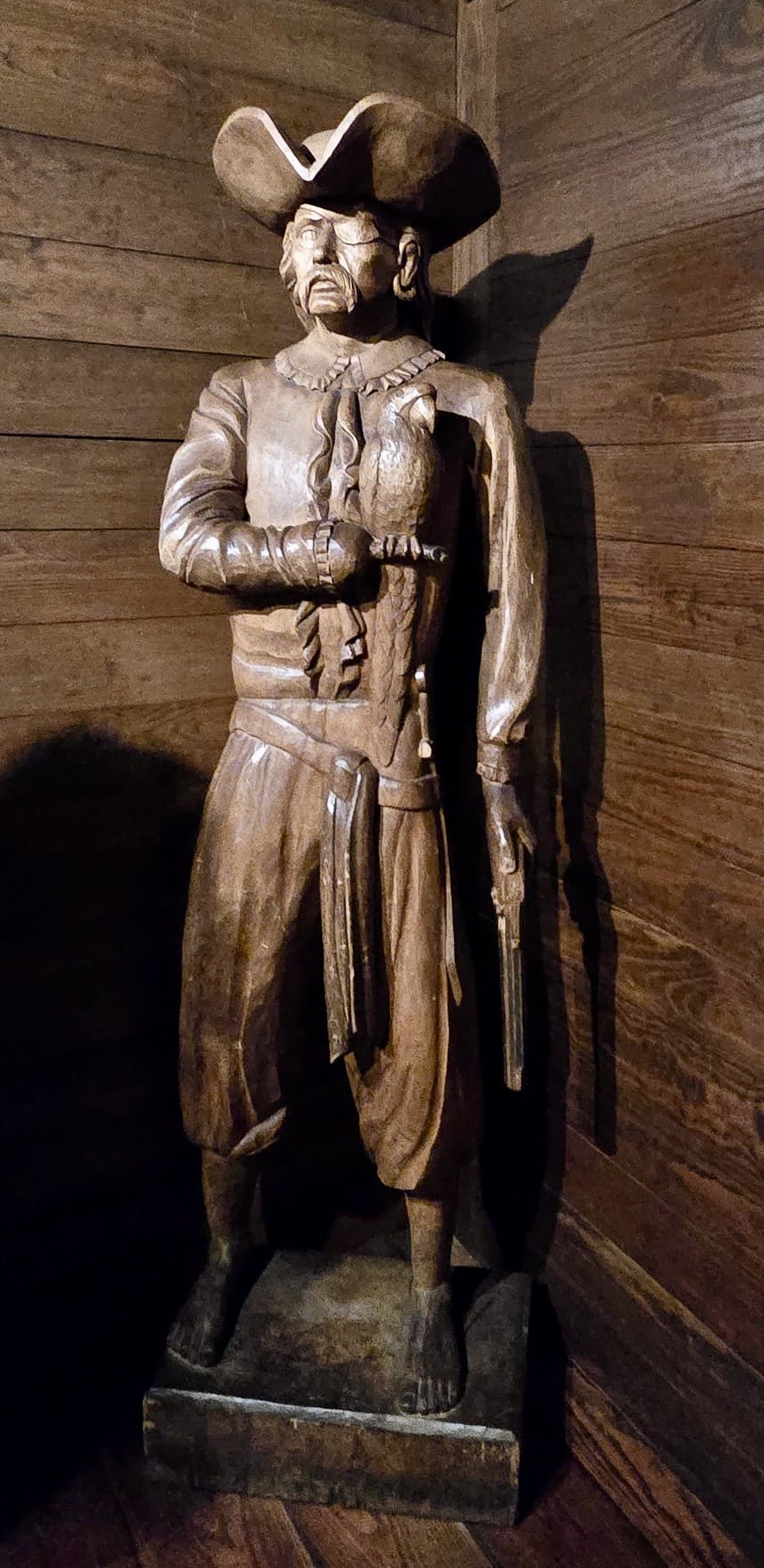
Roland was beside himself and begged Robin to take his picture with the statue who could only be Captain Flint before being let loose in the gift shop to find pirate toys to play with back at the cottage. Robin waved the others on, telling them they’d catch up in a few minutes.
It only took Roland about ten minutes to fully outfit himself with a plastic sword and hook, a pirate hat, and an eye patch, as well as a door hanger with the Jolly Roger flag on it and the caption NO TRESPASSING PIRATE’S TERRITORY. The men all laughed and cheered when he and Robin made their appearance at the table.
“Arrrrrrr, me hearties!” Roland growled, jumping out from around the corner as Robin made his way to an empty seat. He prowled around the table, swinging the sword this way and that until his father admonished him to be careful not to hit anyone or anything with it. Once he was seated, David showed him the kids’ menu and helped him pick his meal of the Frozen Rainbow- a very fruity frozen drink- and Bold Billy Bones, which consisted of fried shrimp and special Pirate’s House fries.
Once all their orders were placed and their waiter withdrew, a female pirate approached. She had long strawberry blonde hair and wore a bright red long-sleeved blouse underneath a leather vest and tight leather pants.
“Ah ha!” she gasped, focusing on Roland at the other end of the table. “It be the villainous Captain Hook.”
Roland didn’t miss a beat. He jumped to his feet, brandishing his sword and challenged the female pirate to a duel. She drew her own blade, and they proceeded to cross swords for just a few seconds, the men whooping and hollering encouragement to Roland before the lady was disarmed. She smiled proudly at the boy and declared him a master swordsman to have defeated the most famous female pirate of all time, Anne Bonny.
She offered to show Roland around the Pirate’s House, and Will jumped up and took Roland by the hand to go see some of the historical artifacts and the rum cellar, stating that he was sure Belle would be interested to hear about it.
While Will and Roland were gone, their drinks arrived. The pirate theme was pervasive throughout the restaurant, and the guys had had a great time choosing their respective drinks. First, they ordered two Diplomatico Rum Flights to share between them all. Well, David and Robin as the designated drivers didn’t indulge in the rum flights but focused on a single cocktail for the evening. David had the Savannah Tea while Robin chose the Savannah Storm. Killian had trouble choosing between Pirate’s Pleasure and Release the Kraken, but finally settled on Pirate’s Pleasure when Liam chose the Kraken. But once the drinks were delivered and Liam offered Killian a sip, he opted for the Kraken as well to accompany his meal. Graham chose the Raspberry Mojito because it reminded him of Ruby, and Will ordered the Skull Crusher in a souvenir skull mug.
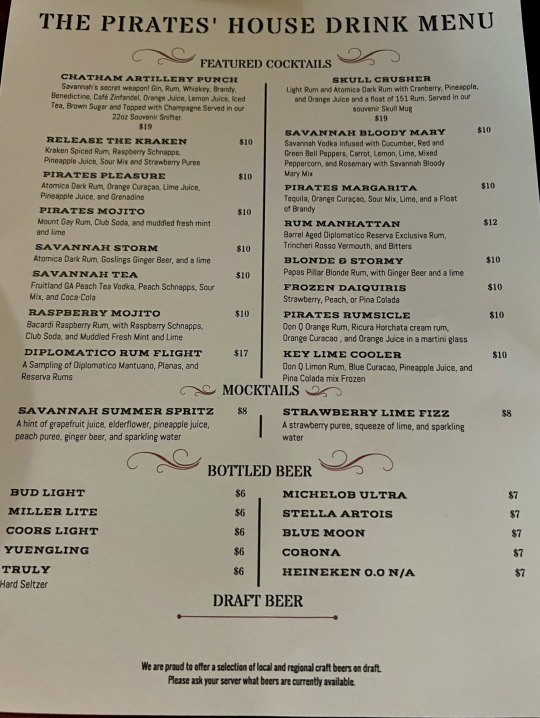
A few minutes later, Anne Bonny, Will, and Roland returned to the table, Will sporting quite a goose egg on his forehead over his right eye.
“What happened to you?” David asked loudly. Roland ran to Robin talking a mile a minute.
“Uncle Will was going down the stairs to the rum cellar and was telling me to watch my step and didn’t see the… the…”
“The bloody roof of the cellar, or floor we’re walking on, whatever,” Will interrupted.
“Yeah, what Uncle Will said,” Roland said, turning back to Robin and continuing his monologue with hardly a breath in between. “And bam, Uncle Will hit his head and then fell on his bottom on the stairs and bump-bump-bumped down to the bottom,” he said, with appropriate sound effects included. “The first step was really big, and Pirate Anne was holding my hand so I didn’t fall, and Uncle Will turned back around just in time to hit his head. He says his noggin is fine, but his butt is sore. Again.” It didn’t take much imagination for the men to realize that those were the exact words out of Will’s mouth when the accident happened, and they all broke into loud laughter.
Will sat down - slowly and carefully - and immediately took a sip of his drink, waving aside the skeptical look Killian shot him.
“I’m fine, Mate,” he said. “But look at the skull! How cool is that?”
“And it’s not even cracked like yours, Mate!” Graham cackled.
The other men all laughed as Will grumbled under his breath before taking another sip.
Roland proceeded to recount all the history and things they’d seen and experienced during their private tour, with Anne Bonny staying at the table to fill in details that Roland missed.
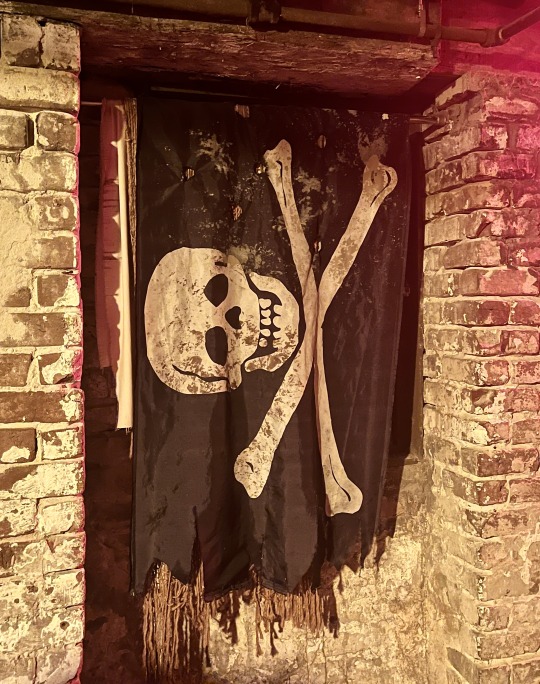
“There was definitely something weird over in the corner of the rum cellar,” Will interjected when Roland was telling them about the giant Jolly Roger flag down there and how there were chains suspended from the ceiling that just started swinging all on their own. “Where the tunnels led down to the river,” Will continued. “Just like an electrical current, felt kind of odd. Not cold, but odd. I don’t know if it was a ghost or not…”
“Of course, it was, Uncle Will!” Roland interrupted. “Captain Flint,” he said, attempting to make his voice low and gravelly. “He died here, remember? It had to be his ghost.”
Everyone laughed good naturedly, then Anne spoke. “No, not Captain Flint, me bucko,” she said, her rich Irish brogue dripping from every word, a mischievous smile on her face, “but perhaps the Rowdy Ghost who usually haunts the Captain’s Room next door. Ee’s been known to follow patrons down to the rum cellar and play tricks on ‘em. Now this room that y’ere in is haunted by the Friendly Ghost. It’s a bit of a misnomer. Ee’s not exactly friendly, but more of a prankster. Ee’ll switch drinks around, steal food, that sort of thing.”
Just then, their meals arrived. Once everyone was served and beginning to dig into the delicious looking and smelling banquet, Liam announced loudly, “Well, I don’t believe in ghosts.”
No sooner had the words left his lips when his plate of parmesan crusted tilapia flipped over, depositing his meal on the surface of the table, the upended plate landing on top. There was stunned silence for a moment before Killian spoke up, hoping to diffuse a potentially traumatic occurrence for the precocious and brave, but still very small, boy in their midst.
“That’ll teach you to say you don’t believe in ghosts inside a clearly haunted house, big brother,” he teased. Roland’s eyes were still as huge as saucers, his mouth hanging open slightly, but he laughed when everyone else did as Liam turned as red as a ripe tomato. Robin shot Killian a grateful look, and Anne grabbed Liam’s plate.
“Aye,” Anne agreed, “It’s never wise to express disbelief in the resident spirits in a haunted house. I’ll just fetch ye a new plate, Sir.”
Once his replacement dinner arrived, Liam joined the rest of them in enjoying the excellent repast. No more ghostly incidents occurred, much to Robin’s relief, and by the end of the meal Roland was yawning nearly every thirty seconds.
Anne appeared again as they were all rising from the table. “Ah, me bucko, I see that ye have cleared yere plate of Bold Billy Bones’ fried shrimp and special fries. And your Tiny Tim dessert as well! Ye’ve earned a trip to Billy’s treasure chest in the lobby.” That got Roland’s attention quickly, and he perked up and took her outstretched hand, following her through the restaurant until they emerged in the lobby. He hadn’t noticed it when they came in, but there in the corner was a real wooden treasure chest filled to the brim with lollipops.
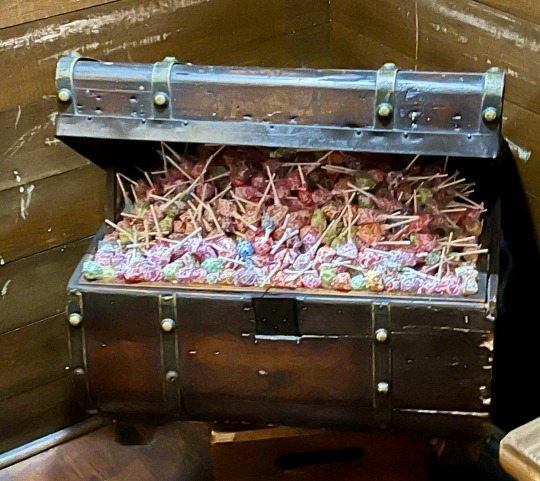
“Can I have one, Papa? Can I?” Roland begged.
“Sure,” Robin agreed, an indulgent smile on his face.
After Roland picked his treat, they all emerged into the night, piled into their vehicles and went to pick up their ladies for the drive home to the cottages.
~*~*~
Notes
As with previous chapters, most of what we had our characters do in this chapter was taken from our actual adventures.
We met Giennie for the day in Savannah and she took us on a tour of one of the very old cemeteries (although our excursion was in Colonial Park Cemetery. We didn’t have time to tour Bonaventure Cemetery like Regina and Robin did). We also drove around some of the squares with the magnificent live oaks and Spanish moss.
With a little bit of time to kill before our reservations for the evening, we took a walk by the river and saw many of the same sights Emma, Killian, Liam and Elsa saw– The Broken Keel, street performers, river boats and memorial sculptures.
We did indeed eat at The Melting Pot, but our dinner was on the way to our rental on the first day of vacation rather than during our primary Savannah day. Unlike the ladies in our story, we opted for the full 5 course celebration rather than the cheese and meat courses alone.
Better Than Sex: A Dessert Restaurant is an actual Savannah restaurant, and while we discussed going, it wouldn’t fit in our schedule. The descriptions of the private party room as well as the names and descriptions of the desserts and cocktails were taken from the restaurant’s website. When we were planning this fic, we had fun choosing desserts and cocktails for the characters.
The Pirate House is also a Savannah restaurant, but this one we did visit. Our evening involved not only dinner at The Pirate House but a haunted tour of the city beforehand and a tour of the (now rum-less) rum cellar. Our table was in the Herb House, which is the oldest part of the restaurant, built in the 18th century. Our waiter was not, in fact, Anne Bonny - historical female pirate - but she made a nice addition to our story. Was she really there? Was she a ghost? Was she a waitress in costume? I guess we’ll never know. The large first step and the low entrance to the rum cellar were real. As we descended the stairs, we immediately knew Will had to crack his cranium one more time as a callback to last year’s fic in addition to denting his derriere. Again. We were also told stories about the ghosts that haunt the Pirate House–from floating orbs to the ghosts named in the story. None of us had any kind of paranormal experience – although one of the guys in our tour group tried to trick our guide into thinking there was – by setting some chains in motion when the guide told us they sometimes move on their own.
Up next on Thursday: Big moments for all of our couples! The most significant being David and Mary Margaret’s wedding, of course – but there are several other secrets revealed, as well as a life-changing moment aboard a riverboat.
~*~*~
Thank you for reading and sharing! We'll be back with our final ch on Thursday!
#destination dream weddings driving disasters & dented derrieres#vacay fic#collab fic#krystal writes#snowbellewells#jrob64#whimsicallyenchantedrose#art by joni
13 notes
·
View notes
Text


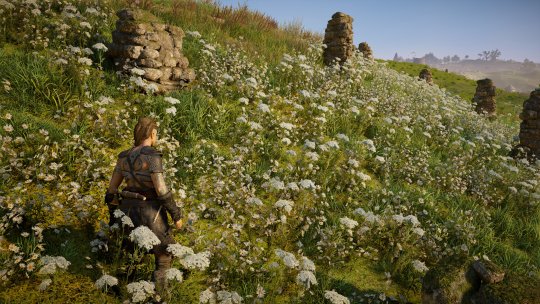
Eivor's herbarium: Page 5 - grasses and yarrow from a cursed zone meadow
~
“From a hill-top meadow west of Grantebridge, where the land breathes again”.
~
Before changing county, I've been thinking about meadows and how agriculturally important they would have been to settlements like Grantebridge or Ravensthorpe. Handily there's a meadow not far from our previous stop outside Soma's longhouse, on a cursed hill-top just west of town.
Cursed zones are small areas on the map where a black roiling fog gathers, horses freak out, and Eivor talks of malevolence and cursed troll magic.

This horse is questioning its life choices...
To dispel the curse you need to find and destroy a skull covered in glowing symbols. Shoot it and the dark fog dissipates, with Eivor saying that the land can breathe again.
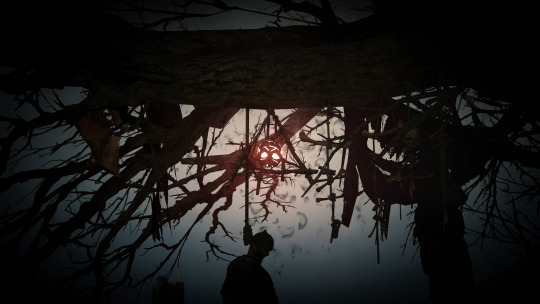
The cursed troll magic symbol
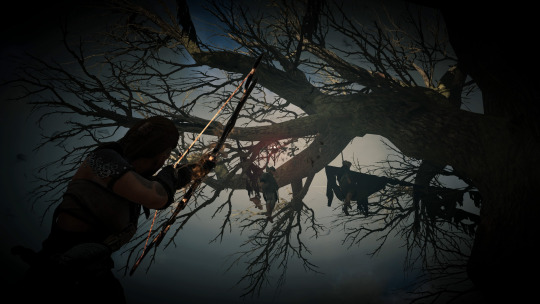
Cursed zones are a slightly odd feature, in that it’s not clear how the ‘magic’ of the curse works. There isn’t an obvious link to Isu tech. We find some notes/snippets of story around suggesting they’re being placed there by Saxons in an attempt to hex away the Danes. In the Wrath of the Druids DLC, the druids are using a recipe that creates hallucinogenic vapor to induce visions of werewolves etc, so the cursed zones could work in a similar way, with the fog being part of the mechanism. But it’s not clear to me unless I’ve missed something.
However they’re supposed to work, cursed zones are good places to find fungi, plants, and honking great big trees. So I quite like them. (I know some gamers hated them and felt they were pointless collectibles; if that’s you, maybe some video game botany will improve them?!)

Aerial view of the hill-top cursed zone west of Grantebridge
The hill-top cursed zone west of Grantebridge has a particularly nice view from above and is surrounded by meadow. Since Eivor is helping run a settlement with farms, I’m sure she’d appreciate the importance of hay meadows to agriculture, and as a source of herbaceous plants for medicinal uses.

In the long grass
What is a meadow?
A meadow is an area of grassland where the vegetation is allowed to grow tall and isn’t cut in spring and summer. In late summer/autumn, the meadow is mowed to make hay, which then feeds farm animals over the winter. Until then, cut meadow is grazed by animals (sheep, cows, maybe goats) which poop as they go, dropping some handy fertiliser around the place. When gets too cold and wet for livestock to be out grazing, animals are brought in and fed on the hay, with the meadow left until spring for the cycle to start over again. This is in contrast to pasture, which is grazed in the growing seasons rather than allowing grasses to get long.

The un-cursed meadow, ready for hay-making
Hay meadows are full of diverse grasses and wildflowers. In AC Valhalla we particularly see yarrow, ox-eye daisies, and grasses like Yorkshire fog (4th pressed grass from the left) and meadow foxtail (2nd from left.)
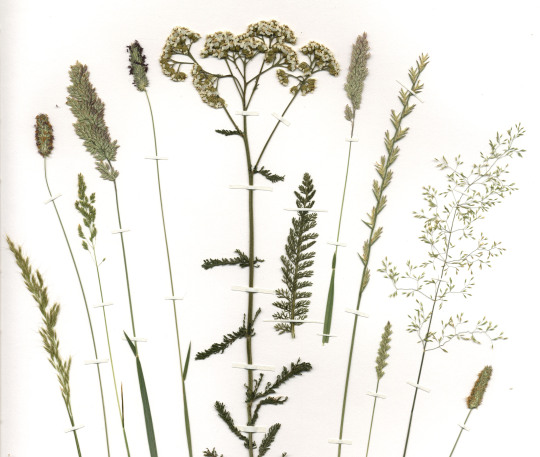
On this page I’ve centred yarrow, mainly because I’m saving the daisies for another page! The grasses are from a couple of square metres in my back garden that I keep as a veeeery smol meadow. I’m lucky enough to have some outdoor space, and my priority in life is generally insects. So I leave some grass to get tall, and encourage a range of local wildflowers and grasses that serve as food for bees, moths, and beetles. In the un-cursed meadow, Eivor might have also seen clover, yellow rattle, lady’s bedstraw, and I’d bet on sweet vernal grass and crested dogstail too (3rd grass from the right.)

Ox-eye daisies in my local cemetery meadow
Hay meadows are an amazing reservoir of wild plant and insect species, but are now a rare habitat. Apart from the obvious changes in agricultural practice, capitalism doesn’t value biodiversity in spaces it could build on, extract from, or intensively farm the crap out of. But hope is not lost for meadow species. Many conservation organisations here work with farming communities to restore former meadows or to create new ones. Churchyards and church lands that haven’t been developed are also important spaces for meadow preservation – and in AC Valhalla we see meadows around the monastery at Meldeburne.
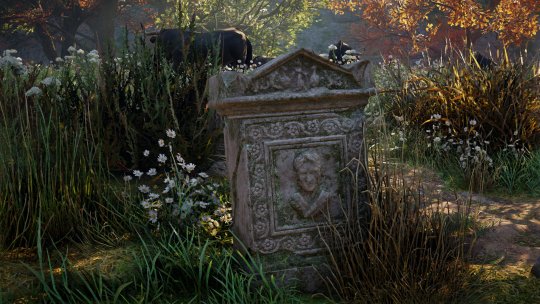
Meadow grasses and flowers around Meldeburne monastery

Yarrow (Achillea millefolium)
Super-common and very tough, yarrow is a component of meadows but is found anywhere grassy – it’s found in lawns and verges all over the UK. In my area you'd be hard pressed not to see any in summer.

Yarrow in my backyard
Feathery, finely divided leaves gave it another common name, milfoil or millefoil, meaning 1000 leaves. It has clusters of small white or pinkish flower heads with an interesting structure. The flat-topped clusters of flowers look like they’re made out of daisy(ish) shaped individual flowers...

...But take a look at those daisy shapes and you’ll see that each is actually a cluster of many smaller tiiiiny flowers that just LOOK like a daisy. The centre is made of a bundle of tube-like ‘disc’ flowers that have 5 petals fused together. These are surrounded by a few ‘ray’ flowers, each with one large petal. So cool!
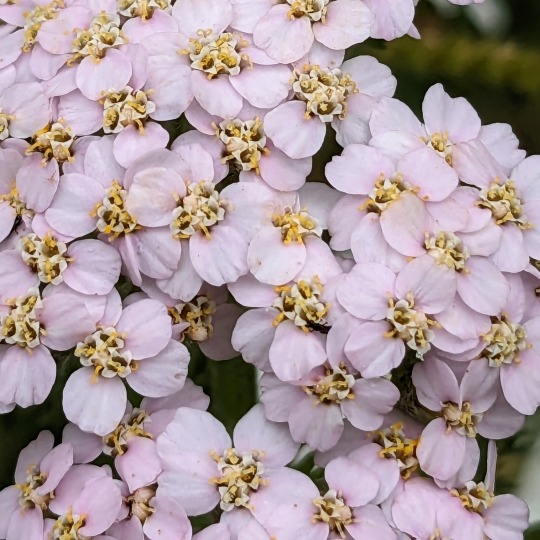
Yarrow: flowers inside flowers
Ecologically, it’s an important source of nectar and pollen for bees, and a food plant for many other insects, including moths and beetles. Some cavity-nesting birds use it as lining material. I encourage it to grow in my lawn along with clover, self-heal and black medick, because it’s a lot hardier and more drought tolerant than any lawn grass.
Historically, yarrow used to be used medicinally to staunch bleeding, but weirdly was also called ‘nosebleed plant’ because of a myth that it caused nosebleeds. It also used to be used as a good luck charm.

Yarrow and ferns
I'm going to move onto the autumnal ferns of Ledercesterscire for page 6, but I'll probably come back to Grantebridgescire for some of the other mysteries.
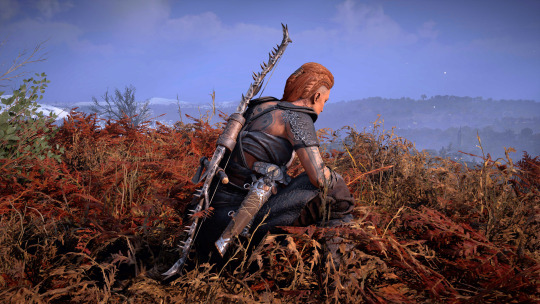
#eivors herbarium#Eivor's herbarium#video game botany#videogamebotany#ac valhalla#assassins creed valhalla#assassin's creed valhalla#lady eivor#eivor wolfkissed#eivor varinsdottir#botany#plants#pressed plants#book herbarium#herbarium#meadows#grasses#yarrow#virtual photography
45 notes
·
View notes
Text




On 8th April 1783 John Loudon, the Scottish architect, landscape gardener and journalist was born.
Loudon was born in Cambuslang, to a respectable farmer. Therefore, as he was growing up, he developed a practical knowledge of plants and farming. As a young man, Loudon studied biology, botany and agriculture at the University of Edinburgh. When working on the layout of farms in South Scotland, he described himself as a landscape planner.
Loudon developed a limp as a young man, and later became crippled with arthritis. Crippled by rheumatism and arthritis, he had to endure an amputation at his right shoulder after a botched operation to correct a broken arm. He learnt to write and draw with his left arm and hired a draughtsman to prepare his plans. At the same time he cured himself of an opium habit that had been keeping the pain at bay.
Around 1803, Loudon published an article entitled Observations on Laying out the Public Spaces in London, he called them Breathing Places and Country Zones.
This led to a series of commissions for landscape projects in which he sought to introduce 'more of the picturesque' into the English landscape. The results were illustrated in his 1806 Treatise on Country Residences.
This experience gave him an admiration for the 'old' 'formal' 'geometric' gardens which had been out of favour in England for a century. He praised them in his Encyclopaedia of Gardening (1822) and later advocated a style of planting design which he named Gardenesque. The aim was to place exotic species in natural compositions. The influence of this idea lives on. Loudon was an advocate of public parks and published important works on glass houses, architecture, horticulture and agriculture.
He wrote a book in 1840 book called The landscape gardening and landscape architecture e of the late Humphry Repton, esq, not the first to use the terms for gardening, he was the one that used them extensively from then onwards.
John Loudon also designed large greenhouses for his parks, the third pic shows one he was commissioned for the Royal Horticultural Society in 1818.
Loudon established himself as a city planner, decades before Frederick Law Olmsted and others began to work. His vision for the possibility of long term planning for London's green spaces was illustrated within his work, Hints for Breathing Places for Metropolis published in 1829. He envisioned city growth being carefully shaped and circulation influenced by the inclusion of green belts, ideas not adopted until well into the 20th century.
His work on cemeteries also was significant. Churchyards were becoming full, especially in urban areas, and new cemeteries were being opened by private enterprises. Loudon designed only three cemeteries (Bath Abbey Cemetery, Histon Road Cemetery, Cambridge, and Southampton Old Cemetery where the design was rejected)but his writing was a major influence on others.
An unusual creation by Loudon is the memorial to his parents, as seen in pic four, which stands in the grounds of St John the Baptist, Pinner's parish church. It is in the form of a stone wedge, with a fake stone sarcophagus within. It has been Grade II listed since 1983.
John Loudon passed away on 14th December 1843 aged 60 in London.
6 notes
·
View notes
Text
KATE LEIGH
KATE LEIGH
1881-1964
Kate Leigh and Tilly Devine ruled Sydney, Australia’s underworld during the 1920s. Leigh was a madam and trader of alcohol, cocaine and ran underground gambling ring from her home in Surry Hills.
Leigh was born in Dubbo, NSW, she was neglected by her parents and went into a girls home aged 12. She gave birth to Eileen in 1900 and married James Ernes ‘Jack Lee (Leigh)’ in 1902, his father was Chinese and mother was Australian. Jack was a petty criminal and they broke up in 1905 and later divorced. In 1922, she married Edward Joseph ‘Teddy’ Barry a petty criminal and later separated. After dating a few men, she married criminal Ernest Alexander ‘Shiner’ Ryan in 1950 and separated six months later.
Leigh made her money from selling alcohol, the law stated bars had to close by 6pm, Leigh ran 20 bootleg outlets. Leigh never drank alcohol, smoked or did drugs - even though she traded them. She had the protection from male criminals who used razors as weapons.
Leigh and Devine remained in conflict during their criminal careers, they had physically fought each other numerous times and their rival gangs remained in constant battle. Even though Leigh was involved in crime, violence and murders she was never convicted for any violent offenses. In 1930 she shot and killed Jon William ‘Snowy’ Prendergast when he and his gang broke into her home. She was also involved in the shooting of Joseph McNamara in 1931. Leigh was imprisoned on other charges including the selling of alcohol and drugs, regardless, she continued business.
Leigh was known for dressing up and wearing jewellery, including diamond rings on every finger and she only wore the most expensive clothing. She was the wealthiest woman in Sydney during the 1930s and 1940s, but the Tax Office sent her bankrupt in 1954 and when bars were able to serve alcohol until 10pm it destroyed her business.
Leigh died aged 82 in hospital on 4 February 1964 at St Vincent’s Hospital, Darlinghurst. She had suffered from a stroke in January of that year and her health went downhill as a result. At the time of her death she was living in poverty in a small room above a hotel in Surry Hills and was financially dependent on her nephew, William John Beahan who ran a shop downstairs. Her funeral at St Peter’s Catholic Church had 700 people attending; she was buried in Botany Cemetery (Eastern Suburbs Memorial Park).
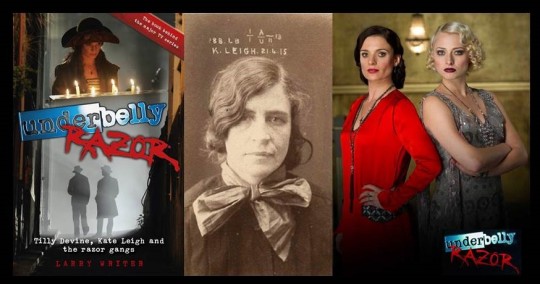
#kateleigh #underbellyrazor #daniellecormack
2 notes
·
View notes
Text
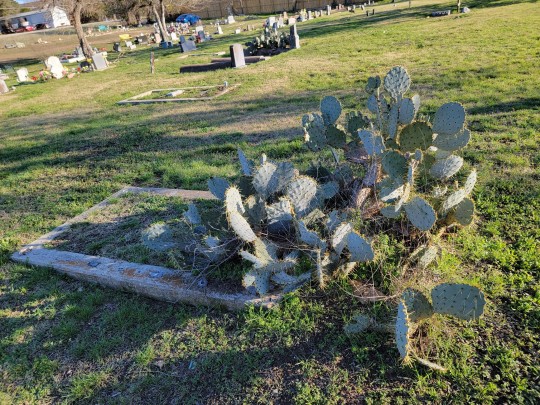

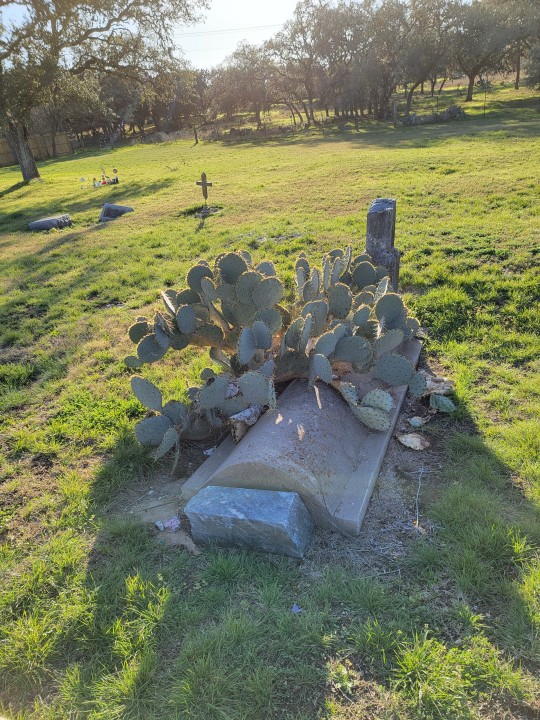

A small collection of grave Opuntia.
173 notes
·
View notes
Text
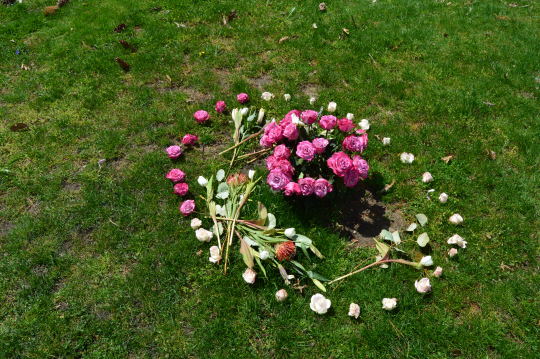

Flower memorial laid out for a loved one buried naturally in a field at Mount Auburn Cemetery. - Cambridge, MA
3 notes
·
View notes
Photo

October Autumn Round Masterlist
Totally aware this roundup is very late, but better to post now rather than never, right? October had a variety of flowery creations for different ships that deserve shout-outs. Definitely check all these works out! This challenge may be over, but folks can still pick any HP Flowers Spring prompt card or Autumn prompt card to make creations and submit them to the AO3 collection, which will stay open until the end of this year (yep, that’s December 31st). Here are all the works submitted for the Autumn round:
Snarry (Severus Snape / Harry Potter)
🥀 Deadly nightshade by Im_just_visiting (G, 12.3k)
After the end of the war, Severus is unable to find his way back to life. He has chosen suicide as the ideal solution. Again. This time there was no Dumbledore to change his mind, and nothing could dissuade him from his decision and make his will to live return. Or at least he thought so.
🌼 Chrysanthemum by emeraldlove | @givereadersahug (M, 1.5k)
"Will you die someday?" asked Severus, still getting used to the word and its implications. He didn't want his mum to die.
"Everyone dies," his mum replied.
🥀 Cardigan by HNWitt15 (T, 1.2k)
For the following prompts: Amaranth: Immortality, Good Luck or Prosperity Alternative: Everlasting Love or Unfading Affection
Dahlia: Eternal Love or Commitment If paired with Myrtle: shows love and devotion
Drarry (Harry Potter / Draco Malfoy)
🌼 The (Re)Marriage of the Century! by lumosatnight | @lumosatnight (T, 1.8k)
Harry and Draco get married (or remarried, depending on how you look at it). The only problem is Harry seems to have wandered off and Draco is tearing his hair out trying to find his missing zombie lover.
Or, a wedding in two parts.
Jegulus (James Potter / Regulus Black)
🥀 everything, in time by tinytintina | @tinytintina (E, 19.3k)
He always knew that his parents would arrange his marriage with someone they deemed worthy.
What he didn't know was this marriage could have place for love too.
Dramione (Draco Malfoy / Hermione Granger)
🌼 A Love Like This Won't Last Forever by ohthedrarry (M, 7.9k)
After the war, Draco hadn't known what to do with himself or Malfoy Manor. He'd tried to settle his mind with a bit of botany - a hidden favorite pastime of his - and soon enough, the estate was covered in hundreds of plant varieties. Hermione was surprised when she received an invitation to the grand opening of The Gardens at Malfoy Manor, a botanical garden for flora and fauna, both Magical and Muggle. Wiltshire breathed a sigh of relief when the two finally came together among a sea of Dahlias.
Snack (Sirius Black / Severus Snape)
🥀 a thousand nights that end like this by slashaholic666 (T, 8.8k)
Truthfully, Sirius wasn't sure how he felt about the referral from the Muggle Healer - no, doctor. An oncologist, according to the plaque outside his door; the man knew how to read radiographs better than the healers stuck in Azkaban at any rate. He was highly advised to make sure his wartime end-of-life planning was still what he wanted.
Snucissa (Lucius Malfoy / Narcissa Black Malfoy / Severus Snape)
🌼 my bones have found a place by fortunedays | @sapphicathenas (T, 7k)
She had been Narcissa Black when she met them, young and foolish. She’d loved Lucius first – it was easy, and expected – but the love for Severus, too, had crept up on her. Lucius had fallen for him first, as he had with her, but she fell harder, and had done her best to keep the three of them together, even when she became Narcissa Malfoy and everything was much more difficult. But, as she steps beneath the cemetery’s archway, she is Narcissa Black once again: older and still just as foolish, to think there had been a future for them.
She has buried her husband and, now, her lover. And she is very, very alone.
Petunia and Severus
🥀 a rock and a hard place by inmyownlittlecorner | @inmyownlittlecorner5 (Podfic)
Raising four-year-old Harry Potter alongside her own son with little support has Petunia at her wit's end. One afternoon a pair of mysterious strangers approach her with an offer that would rid her of Harry forever. But will this devil's bargain truly free her--or will it bury her for good?
#hpflowers2022#hp fests#masterlist#autumn round#snarry#drarry#jegulus#dramione#snack#snucissa#petunia evans#severus snape#multiship#hp rare pair#hp triad#hp fanart#hp fanfic
28 notes
·
View notes
Photo
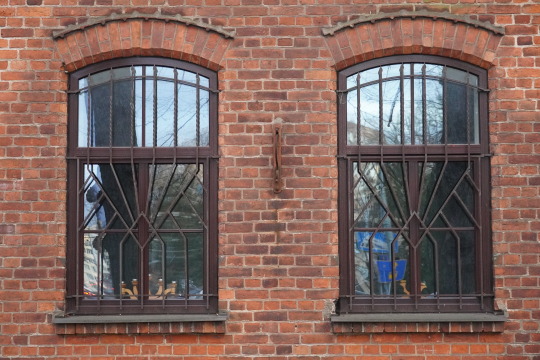

The Great Cemetery, Riga
#grille#window#Riga#Latvia#2022#brown grille#wrought iron#geometric grille#symmetrical grille#botany grille#cemetery
1 note
·
View note
Text

Zephyr's Cadence: Homecoming
(Vierapril Day 17 - Home)
-------
After decades away, the two Viera return to Rabanastre and visit an old friend.
-------
Read on AO3 or keep reading after the jump
content warnings: cemeteries and implications of death
Check out the main Vierapril 2023 post here
------
For the Vierapril prompt 'home', the boys get to be happy, darn it. They're going to be happy! Eventually! Homecoming takes place after all the MSQ is done, so there are no longer any world-ending threats the WoL and the Scions need to take care of. It's time for the future and for some rest.
Vierapril 2023 Day 17 - Home
"Do you really think it's still standing?"
"There's only one way to find out." Kris smiles back at Laurent as they walk through the streets of Rabanastre. The restoration had begun in earnest, but Dalmasca's capital still had a long way to go before it was back to its former glory.
The two Viera carefully made their way along the familiar streets, making sure not to trip on any rubble or get in the way of any of the workers. When another group of builders rushes past, Kris lets out a small sigh.
"Is something wrong?" Laurent moves closer to the light-haired Viera and lightly touches his arm. In response, Kris chuckles and shakes his head.
"Quite the opposite--it's nice to not be recognized."
Laurent responds with an amused hum as he interlaces Kris's fingers with his own. Being the Warrior of Light and the savior of the star made Kris the center of attention on many occasions, and depending on where they were, not a day would go by without him being stopped for some reason or another.
Though he met everyone with a smile and never turned anyone away, Kris found it frustrating regardless. Laurent found himself being recognized from time to time as well--something he dealt with much less gracefully than his partner did. They both simply wanted to have a quiet, peaceful life, free of the burdens of being a 'hero'.
"This area doesn't look like it took a lot of damage." Kris stops and turns to Laurent, squeezing his hand. "It's just around the corner. Are you ready?"
The dark-haired Viera nods and smiles, and the two make their way around the corner and look down the street. After a moment, Kris breaks into a wide grin. "Ah, the bar is still standing after all!"
"Hmph, the building's just as tough as its owner was." As they get closer, Laurent eyes the broken front door. "Seems the bandits got to the place, though."
"It's no surprise, it's been decades. I would be more surprised if a bar of all places wasn't ransacked." Kris picks up a large piece of the splintered door and shoves it aside. "Shall we see if there's anything left?"
Laurent nods, though his expression turns more serious when he speaks again. "Let us not stay too long--we still have another place to visit before the sun goes down."
"Of course." Kris gives a nod in turn, then carefully ducks into the bar.
Unsurprisingly, the inside of the bar did not hold up well to decades of looting and neglect, but as the two Viera looked around, it was clear that what remained could be salvageable. After a bit of rummaging, Kris turns around excitedly. "I will need to fix it up a bit, but we'll be able to live here once you're done with your studies."
"Yes, you're right." Laurent smiles, then looks away. "We do not need to wait to come here on my account, I don't want to hold you back--"
"Nonsense." Kris walks over to the dark-haired Rava and grabs his hands while smiling brightly. "You never do anything for yourself. You were so excited when you were accepted into the Studium, Reyna. You might have actually smiled for more than a minute!"
"Eir, please--"
"What I'm saying is that there is no need to rush." The emerald-eyed Viera gives Laurent a light kiss on the cheek. "We have the rest of our lives ahead of us! Not to mention, everything you'll learn about botany will no doubt be useful out here."
"...I suppose you're right." Laurent pulls Kris into a tight hug before turning his gaze to the door. "We should get going, though, so we're not stumbling through the dark."
"Right, let's go then. Why don't you tell me about your latest project while we walk?"
~
The two Viera look up at the simple gate as Laurent crosses his arms. "I'm surprised it's untouched."
Kris gives a light shrug as he opens the gate. "The Garleans know better than to disturb graveyards. Too many soldiers killed for desecrating them."
"By the locals?"
"Usually vengeful spirits. Speaking of, we should get moving before we have to deal with one of our own." Kris chuckles lightly as he steps through the gate, with Laurent closely following behind.
It doesn't take them long to stop at a particular tombstone, and Kris bends down to brush the dust from it. "It's been a while, Gemna. The war got in the way of visiting, but we'll be able to come by more often now."
Kris's ears tilt back slightly as Laurent makes a choked cough, but he doesn't turn around. He knows the fuchsia-eyed Viera needs time to gather his emotions. Instead, he continues to clean the grave. "So much has happened, far too much to catch you up on today, but Reyna and I will tell you all about it when we visit."
As the light-haired Rava stands up and brushes his legs, he breaks into a wide grin. "You'll be so proud--Reyna was accepted into the Studium! In Sharlayan! He's studying the aetherial qualities of soil and how it can be manipulated to grow plants anywhere. He'll figure out how to grow flowers in the desert, I'm sure."
"Eir, I never said I would do that. Or could do that." Laurent lets out a huff as he approaches the grave, though the look on his face was more amusement than annoyance.
"Be more confident in yourself, my love. You've already made so much progress." Kris turns to Laurent and gives him a wink. "That Archon mark will look nice on you." Laurent responds with another huff as his cheeks redden.
Kris chuckles before he continues. "We're going to get married, as well! And it was Reyna's idea, if you could believe it."
"Gods, Eir, stop teasing me--"
"I'm not teasing you! I thought it was a very sweet idea. Only the gods know how many hours I've spent figuring out the perfect feast. And how many hours you spent looking into flower arrangements." Kris shifts his gaze beyond the tombstone to the horizon. "Alas, the sun is already setting. We'll have to tell you all about it on our next visit." His gaze returns to the grave as he falls silent.
"Gemna…" Laurent kneels down, lightly touching the tombstone. "Thank you for always watching over us. We're doing alright." He stays kneeling for a moment before Kris offers his hand.
"Time to go, my love."
"Yes." Laurent takes the offered hand and pulls himself up, then looks down at the grave with a small smile. "We'll be back soon."
#vierapril#vierapril 2023#ffxiv viera#ff14#ffxiv#final fantasy xiv#final fantasy 14#ao3#ffxiv fanfiction#ffxiv fic#ffxiv oc#ffxiv wol#my oc#series: zephyr's candence
5 notes
·
View notes
Text
The lives of others: fictional memoirs

Human beings are peculiar creatures. Take away the basic features that distinguish us as a species and we can be so vastly dissimilar as to kill one another over our differences. Ironically enough, each one of us tends to sprout into several different versions of ourselves based on the choices we make and the experiences we have as we age and mature, to the point that we can barely recognise or associate with our younger selves as we look back.
That’s part of the fascination of fictional memoirs, in particular those that extend throughout a character’s entire life spam. They tend to be huge books, filled with many characters whose names are not always easy to remember and whose imaginary faces we have to change in our minds as we go forward, or sometimes back and forth, through the decades. I see how that can be a deal breaker to some, but you know what? I like it. Often better than actual memoirs.

The first book that comes to mind is “The Signature of All Things”, by Elizabeth Gilbert, which I would describe as, drum roll please - a botanical drama. Alma is a (Capricorn, through and through) woman born in a newly rich family in the year 1800. Gilbert does us a favour and uses as many round numbers as possible so we can situate ourselves easily in time. As Alma grows up (and old) we go through several different subgenres, starting with the obvious coming-of-age and ending in a classic adventure in the style of Jules Verne and Robert Louis Stevenson.
I was positively surprised, as the latter is a markedly male-dominated genre, and Gilbert brilliantly succeeds by managing to maintain the excitement of the journey without giving up the more well-rounded character-driven narrative she has set up from the beginning. In fact, Alma is a typical self-centred, isolated intellectual, so every social connection she makes has a bigger and deeper meaning. Even her approach to sex has a scientific interest as well as physical. And all that comes wrapped in lots of fun facts about bryophytes, so buckle up, my botany-lover friends!

Other examples of character-driven fictional memoirs are the sweet “The One Hundred Years of Lenni and Margot”, by Marianne Cronin, set in a cancer hospital ward, where 17-year-old Lenni and 83-year-old Margot reminisce on their joint 100 years of life as they develop an art project together; the bestseller “The Seven Husbands of Evelyn Hugo”, by Taylor Jenkins Reid, where an old Hollywood star gets candid about her past in a conservative industry that held more secrets than truths; and a personal favourite, Valérie Perin’s breathtaking “Fresh Water for Flowers”, whose main character is a cemetery’s groundskeeper with a tragic and melancholy past that slowly unfolds as we accompany her in her peaceful routine, getting a glimpse here and there of the life of the people buried in the cemetery - their families, friends and lovers.

As we enter the realm of historical fiction, Isabel Allende’s “Violeta” is a good example of a fictional main character living in a very real world. Following a similar structure to “The Signature of All Things”, the book starts with Violeta’s birth in 1920 (again a round number!), amidst the Spanish flu pandemic, and ends with Violeta’s 100th birthday in 2020, this time amidst the coronavirus pandemic. Through Violeta’s personal story, full of twists and turns, we are educated on 100 years of political turmoil in South America, with Violeta’s own political awakening coming about during the military dictatorship in Chile.
Another fictional memoir that can be quite educational is Jorge Amado’s “Tent of Miracles”, using the death of a fictional poet named Pedro Archanjo to go back and forth in time and dive into Brazil’s racial history, from Afro-American religions and culture to the origins and ramifications of racial prejudice. Despite the very serious subject, Amado’s characteristic satire and mild debauchery are very present, making it an unexpected light read.

But perhaps the most popular branch of historical fiction is the fictional biography of real-life characters. Taking our subject matter here, which are narratives that span through decades of a character’s life, Irving Stone is a recent discovery I’m very excited about. So far I’ve only read “The Agony and the Ecstasy”, a very complete, 800-page long fictional biography of Michelangelo whose level of detail is so impressive and the tone is so on point that for a while I felt I was living in Renaissance Italy.
I’m sure the research required to pen such a novel is akin to that of a PhD, with the degree of difficulty increasing as you go further back in time. Which I suppose was what led Sue Monk-Kidd to rely more heavily in guesswork with “The Book of Longings”, set in the time of Jesus Christ, mixing biblical sources and historical speculation to recount the origins of Christianity, but with an added element that instigates debate in academic circles: that Jesus Christ could have had a wife. Despite a few exaggerations to match contemporary perspective, the author does a really good job of making the book both unoffensive to Christians and appealing to non-Christians.

Some other authors prefer to write in instalments, with each book reflecting a different stage in the main character’s life. L. M. Montgomery’s “Anne of Green Gables” series starts when Anne is only 11 and by the end of the last book she is 75 - and no longer the protagonist. Meanwhile, the more poignant “My Brilliant Friend” series, by Elena Ferrante, follows characters Lena and Lila from their early childhood all the way to their 60s, with protagonism shifting between the two friends as their lives take different paths throughout each book, despite Lena being the full-time narrator.

And then there are the more peculiar variations of the genre - such as Virginia Woolf’s “Orlando”, a mix of romance, history, semibiography and magical realism spanning 350 years in the life of main character Orlando; “Us”, by David Nicholls, which is not the fictional memoir of a person, but of a 25-year marriage that has come to an end; Khaled Hosseini’s “And the Mountains Echoed”, with each chapter conducted by a different character, covering 60 years of Afghan history; and, of course, “One Hundred Years of Solitude”, by Gabriel García Márquez, an unmatched family epic whose incredible metaphor of the cyclic nature of human beings continues to resonate two generations after it was first released.

No question has tormented our species harder than the meaning of existence. This might be part of our unconscious reason to seek biographies, real or not. We go looking for directions on how to live our lives - and leave with the comfortable (and true) realisation that no two people have ever walked the same path on Earth. More than that, we learn that plans change, goals evolve and, whilst time might not heal all wounds, it certainly makes them better. It makes us better.
#books and libraries#writers#book blog#booklr#bookworm#bookish#books and reading#book recommendations#book reviews#historical fashion#have you read this too#HYRTT writing
0 notes
Text
Wk 17, 28th of May, 2024 Research
Language built from Nature
From the text: THE WEB OF LIFE by Chief Seattle...
Nearly 150 years ago, Chief Seattle, a wise and widely respected native Red Indian Chief delivered this compelling message to the government in Washington, which wanted to buy his peoples land. This is perhaps the most eloquent statement ever made on the environment.
How can you buy the sky? Chief Seattle began. How can you own the rain and the wind? My mother told me, Every part of this earth is sacred to our people. Every pine needle.
Every sandy shore. Every mist in the dark woods. Every meadow and humming insect. All are holy in the memory of our people.
Further,
From the text: Speaking of Nature: finding language that affirms our kinship with the natural world by Robin Wall Kimmerer...
A CEMETERY SEEMED AN ODD PLACE to contemplate the boundaries of being. Sandwiched between the campus and the interstate, this old burial ground is our cherished slice of nearby nature where the long dead are silent companions to college students wandering the hilly paths beneath rewilding oaks. The engraved names on overgrown headstones are upholstered in moss and crows congregate in the bare branches of an old beech, which is also carved with names. Reading the messages of a graveyard you understand the deep human longing for the enduring respect that comes with personhood. Names, names, names: the stones seem to say, “I am. You are. He was.” Grammar, especially our use of pronouns, is the way we chart relationships in language and, as it happens, how we relate to each other and to the natural world.
Tiptoeing in her mud boots, Caroline skirts around a crumbling family plot to veer into the barberry hedge where a plastic bag is caught in the thorns. “Isn’t it funny,” she says, “that we think it’s disrespectful to walk over the dead, but it’s perfectly okay to disrespect the other species who actually live here?”
We have a special grammar for personhood. We would never say of our late neighbor, “It is buried in Oakwood Cemetery.” Such language would be deeply disrespectful and would rob him of his humanity. We use instead a special grammar for humans: we distinguish them with the use of he or she, a grammar of personhood for both living and dead Homo sapiens. Yet we say of the oriole warbling comfort to mourners from the treetops or the oak tree herself beneath whom we stand, “It lives in Oakwood Cemetery.” In the English language, a human alone has distinction while all other living beings are lumped with the nonliving “its.”
As a botany professor, I am as interested in the pale-green lichens slowly dissolving the words on the gravestones as in the almost-forgotten names, and the students, too, look past the stones for inky cap mushrooms in the grass or a glimpse of an urban fox. The students out for a walk on this late fall day are freshmen in Janine DeBaise’s environmental writing class at the SUNY College of Environmental Science and Forestry where we both teach. I’ve invited them on a mission to experiment with the nature of language and the language of personhood. Janine would correct me: she would not refer to her students as “freshmen” since they are neither fresh nor all men. We call them “first-year students.” Words matter. She has collected their assignment, a written reflection on a cemetery walk last week, as baseline data. Now we revisit the same place, but with new ideas about grammar bouncing around in the students’ heads. New to them, perhaps, but in fact ancient—the grammar of animacy.
For me, this story began in another classroom, in another century, at the Carlisle Indian School where my Potawatomi grandfather was taken as a small boy. My chance of knowing my native language and your chance of ever hearing it were stolen in the Indian boarding schools where native children were forbidden to speak their own language. Within the walls of that school, the clipped syllables of English replaced the lush Potawatomi sounds of water splashing on rocks and wind in the trees, a language that emerged from the lands of the Great Lakes. Our language hovers at the edge of extinction, an endangered species of knowledge and wisdom dwindling away with the loss of every elder.
So, bit by bit, I have been trying to learn my lost language. My house is spangled with Post-it notes labeling wiisgaak, gokpenagen, and ishkodenhs. It’s a very difficult language to learn, but what keeps me going is the pulse of animacy in every sentence.
It’s no wonder that our language was forbidden. The language we speak is an affront to the ears of the colonist in every way, because it is a language that challenges the fundamental tenets of Western thinking—that humans alone are possessed of rights and all the rest of the living world exists for human use. Those whom my ancestors called relatives were renamed natural resources.
Birds, bugs, and berries are spoken of with the same respectful grammar as humans are, as if we were all members of the same family. Because we are. There is no it for nature. Living beings are referred to as subjects, never as objects, and personhood is extended to all who breathe and some who don’t. I greet the silent boulder people with the same respect as I do the talkative chickadees.
Linguistic imperialism has always been a tool of colonization, meant to obliterate history and the visibility of the people who were displaced along with their languages. But five hundred years later, in a renamed landscape, it has become a nearly invisible tool. We forget the original names, that the Hudson River was “the river that runs both ways,” that Devils Tower was the sacred Bear Butte of the Lakota.
Beyond the renaming of places, I think the most profound act of linguistic imperialism was the replacement of a language of animacy with one of objectification of nature, which renders the beloved land as lifeless object, the forest as board feet of timber.
Because we speak and live with this language every day, our minds have also been colonized by this notion that the nonhuman living world and the world of inanimate objects have equal status. Bulldozers, buttons, berries, and butterflies are all referred to as it, as things, whether they are inanimate industrial products or living beings.
But I wonder if it was always that way. I can’t help but think that the land spoke clearly to early Anglo-Saxons, just as it did to the Potawatomi. Robert Macfarlane’s wonderful book Landmarks, about land and language, documents myriad place names of great particularity that illuminate an ancient Anglo-Saxon intimacy with the land and her beings.
It is said that we are known by the company we keep, and I wonder if English sharpened its verbal ax and lost the companionship of oaks and primroses when it began to keep company with capitalism.
“Aakibmaadiziiwin,” he said, “means ‘a being of the earth.’”
access here: https://orionmagazine.org/article/speaking-of-nature/
0 notes